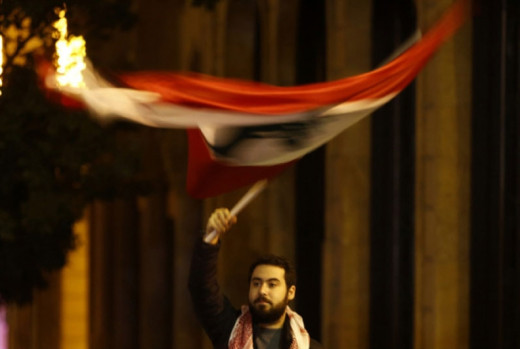A Contribution to Analyzing the Structure of the Ruling Class in Lebanon

Perhaps the date of the beginning of the formation of the Lebanese oligarchy (not as a class but as a structure), dates back to the era of independence, and specifically to the era of Bechara El Khoury. It is the "consecium" (as called by journalist Iskandar Riachi), who at that time supervised the financing of the upcoming president's campaign and ensured his accession to the presidency. This is in exchange for his pledge and absolute commitment to the quality of representation of the interests of the business class, and ensuring advanced concessions to it. It is the solid core surrounding the President, made up essentially of his relatives and associates, who did not exceed thirty families. Khoury, Pharaoh, Sheha, Fattal ... and a few other families took control of the economic summits, especially its financial and commercial sectors. During this stage, the process of converting the Lebanese economy into a "free economy" was completed.
Fawaz Traboulsi summarizes the situation accurately and clearly, in his distinguished study of the social classes in Lebanon (published by the Heinrich Bell Foundation 2013), where he says: “With the era of Bechara El Khoury, the distinguished relationship between the President of the Republic and the banks begins. Each president of the republic has its own bank and bankers. Thus, "Pharaoh Bank - Shiha" was known as Bechara El Khoury Bank. He funded the scandal election campaign for the parliamentary elections for the Constitutional Party, May 1947, and he was known as the "Black May", because of the widespread vote purchase and the rude and shameful interference in the authorities. The era of President Camille Chamoun was the golden era for Lebanese banking capital. Where the Bank of "Lebanon and Overseas" and "Societe Generale" dominated most of the Lebanese economy, and President Shimon was an agent, but rather a shareholder in both banks.
As for the bank of President Fouad Shehab, it is well known that it was "Antra" Bank. This bank has managed 60% of the Lebanese economy, is managed by the security services (the second office in the army), and through it it finances elections, political and media friends. During the era of Charles Al-Helou, Al-Ahed Bank was the “National Bank”. As for Suleiman Franjieh, he was a founding member of the Bank of the Near East. Elias Sarkis, who is coming from the central bank, was the first banker, and he was previously appointed as the chairman of the Board of Directors of “Wedge” bank to its owner, the great businessman Issam Fares. Behind Amin Gemayel, Litex Bank and its director, Sami Maroun, was a friend of Gemayel and his partner, up to the era of Emile Lahoud and the loud bank scandal of Al-Madinah, as well as the role and governor of the Central Bank that was strengthened during his reign, in its control of the financial and economic joints of the country as a whole.
Are We Facing a Classical Mafia Today?
Thinker Pino Arlacchi is trying to define a theoretical definition of the mafia system "where the mafia power is based on a state of chaotic rivalry to attain Jah. It represents an excellent tool for social advancement in a capitalist society, where adventure and immoral idleness are the inevitable conditions for achieving this success”.
That is, the mafia authority here is somewhat implicit and undeclared to protect and secure the interests of the ruling class. By using these "immoral" methods to confront market chaos first (here it represents an administrative role in the relative sense of the word or even "organizational"), and against public opinion and popular forces secondly. The purpose of this division is the peaceful allocation of sectors of influence and business. The waste landfill crisis, for example, may clarify the meaning vis-à-vis theoretical determination. The eruption of the waste crisis around the sharing of landfill dividends in 2015 found a mafia solution for it, through a peaceful division in the two landfill deals on the Lebanese coast, as explained by the New York Times, where the first landfill took place, benefiting from the jihad of Arabs close to Prime Minister Saad Hariri at a value 288 million dollars. As for the second contract, he went to Danny Khoury, who is close to Aoun's family, at a value of 142 million dollars. In the same way, the rest of the files are managed, as the electricity file is shared between "Kojiko", Walid Jumblatt, which has a monopoly on the supply of fuel for generators, and the Turkish Gebran Basil steam generators and deals, which amounted to millions of dollars. In the same vein, the rest of the files belonging to the maritime properties (the scandal of the "Eden Bay Resort"), customs, and illegal crossings ... pass through the Council for Development and reconstruction, the House of Representatives, and other institutions, deals, rents, and spheres of influence are distributed "in love", if true, through Adjusting internal competition according to the mafia logic of each according to its size.
But despite this, the Lebanese political system deviates in its nature from the pure or exemplary mafia system, with its sectarian and sectarian advantage. If we consider that the mafia power is the instrument of ruling the capitalist class (or its means of ruling), then the Lebanese system is not limited to it, using with it another tool which is sectarianism.
The mafia authority represents a kind of unspoken implicit division to protect and secure the interests of the ruling class
In defining sectarianism, we turn to Mahdi Amel. The sectarian system is not the rule of a sect, or the dominance of a sect over a particular political system, or the rest of the sects, but rather the resort of a political authority, or a ruling class, to the use of sectarian and doctrinal primitives in ruling and controlling the existing societal system (see Introduction to denouncing sectarian thought) . It is an imperative necessity for the ruling classes in the late colonial structures, as it is unable to impose hegemony through modern democratic means (parties, unions and civil society institutions), and it is obliged to use pre-political sayings and tools, such as sect, sect, and even the clan.
In this case, by combining Arlachchi and Amel, it is possible to see the complementarity of the concepts - mafia and sectarian - manifested in an exemplary and clear manner in the Lebanese system, which makes it a subject for fertile and generalized studies. No reform or reformative outlet can be found within the existing mafia and sectarian frameworks. The sectarian system is a closed system with complete excellence, as explained by a worker. It operates according to self-propelled rules that guarantee its self-renewal and reproduction for itself, and indeed here is the most dangerous, empowering and strengthening itself, especially in overcoming major crises and contradictions. That is, the sectarian system emerges stronger and strengthened in overcoming any structural crisis (for example, the sectarian structure is strengthened in both Syria and Iraq, following the two recent crises in both countries). Reform and change come from outside. From outside the ruling sectarian mafia system, and it may be through "injecting it", so to speak, with new transformational political forces, we do not say volatility, but rather we amend the existing rules and mechanisms of the existing corrupted mechanisms. Early parliamentary elections may be a window that allows clean air to enter, to purify the rotten air inside the political herd that is currently raging the country. Provided that the 10452 square kilometers are one constituency, no less!








